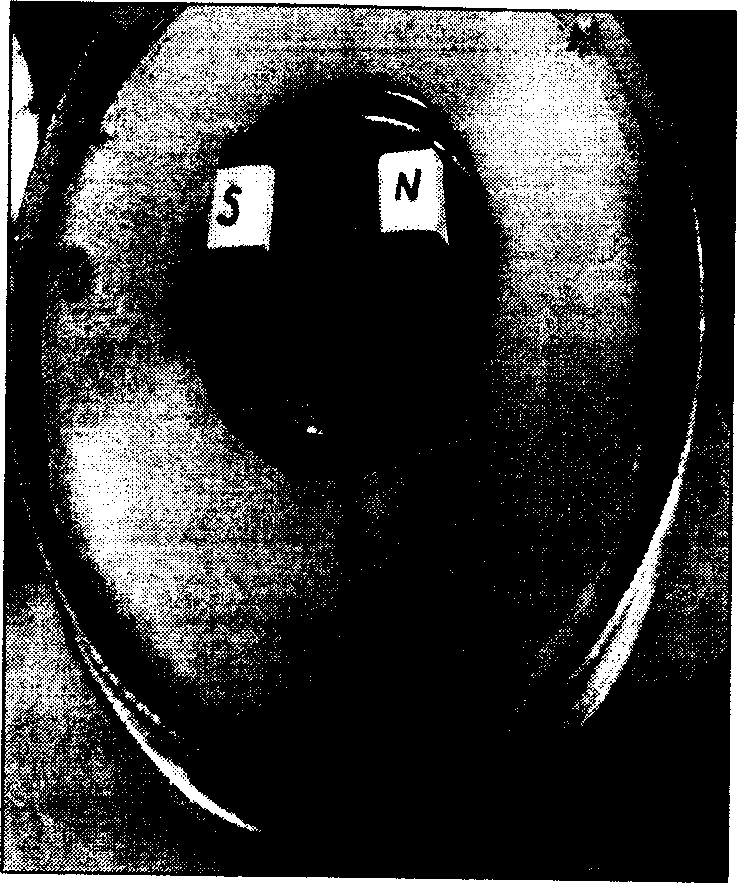Implantation body with biological activity of drug controlled-releasing function, its controlled releasing method and preparing method
A bioactive, drug-controlled release technology, applied in the field of magnetic fields, can solve the problems of patient inconvenience, increased clinical use, and increased use costs
- Summary
- Abstract
- Description
- Claims
- Application Information
AI Technical Summary
Problems solved by technology
Method used
Image
Examples
example 1
[0036] Example 1: The effect of oscillating magnetic field on drug release in vitro from blood clot containing superparamagnetic streptomycin PELA microspheres
[0037] 1. Preparation of superparamagnetic chitosan nanospheres
[0038] Preparation of superparamagnetic nano-magnetic chitosan nanoparticles by chemical co-precipitation method: 57.40 g of the mixture of ferrous ammonium sulfate and ferric ammonium sulfate [Fe 2+ / Fe 3+ (mol)=1.2], dissolved in acetic acid solution containing 2% SC (w / v) (pH, 5.5) to prepare liquid A, and transferred to a stirred 500mL three-necked flask; prepare 6mol / L NaOH to form liquid B ; Under nitrogen protection, heat liquid A to 55°C while stirring rapidly. Quickly drop into solution B, and maintain the reaction for 10 minutes; reduce the stirring speed, heat solution A to 85°C, and maintain the reaction for 90 minutes; add an appropriate amount of glutaraldehyde, and maintain the reaction for 30 minutes. Wash with distilled water to remo...
example 2
[0049] Example 2: In vitro drug release by oscillating magnetic field to gelatin microsphere scaffold containing superparamagnetic chitosan hVEGF plasmid
[0050] 1. Preparation of superparamagnetic chitosan nanospheres
[0051] Preparation of superparamagnetic nano-magnetic chitosan nanoparticles by chemical co-precipitation method: the same as Example 1. (slightly)
[0052] 2. Human VEGF 165 -Red fluorescent fusion protein eukaryotic expression plasmid (pDsVEGF 165 Red1-N1) was donated by Dr. Zou Haibo from China-Japan Friendship Hospital.
[0053] 3. Superparamagnetic chitosan pDsVEGF 165 Preparation of Red1-N1 gelatin microspheres
[0054] Preparation of superparamagnetic chitosan pDsVEGF by cross-linking and curing method 165 Red1-N1 plasmid gelatin microspheres:
[0055] 1. Superparamagnetic chitosan (chitosan content about 800mg) 5ml (acetic acid buffer solution pH5.5), heated to 55 ° C, 20% (w / v) concentrated plasmid (pDsVEGF 165 Red1-N1) 8ml was heated to 55°C...
example 3
[0072] Example 3: Effects of different oscillating magnetic field strengths on the in vitro drug release of gelatin microsphere scaffolds containing superparamagnetic chitosan hVEGF plasmids
[0073] Preparation of superparamagnetic chitosan nanospheres, superparamagnetic chitosan pDsVEGF 165 Preparation of Red1-N1 Gelatin Microspheres and Superparamagnetic Chitosan pDsVEGF 165 The preparation of the Red1-N1 plasmid gelatin microsphere scaffold was the same as in Example 2. The arrangement of in vitro dissolution experiment and the intervention method of oscillating magnetic field are adjusted as follows:
[0074] 1. Prepare 4 groups of the same superparamagnetic chitosan pDsVEGF 165 Red1-N1 plasmid gelatin microsphere scaffold, numbered 1, 2, 3, 4. Three pieces in each group were put into a 25ml Erlenmeyer flask, and 20ml of phosphate buffered solution (PBS solution) was added for later use.
[0075] 2. Apply different gradually increasing oscillating magnetic fields to e...
PUM
 Login to View More
Login to View More Abstract
Description
Claims
Application Information
 Login to View More
Login to View More - R&D
- Intellectual Property
- Life Sciences
- Materials
- Tech Scout
- Unparalleled Data Quality
- Higher Quality Content
- 60% Fewer Hallucinations
Browse by: Latest US Patents, China's latest patents, Technical Efficacy Thesaurus, Application Domain, Technology Topic, Popular Technical Reports.
© 2025 PatSnap. All rights reserved.Legal|Privacy policy|Modern Slavery Act Transparency Statement|Sitemap|About US| Contact US: help@patsnap.com



